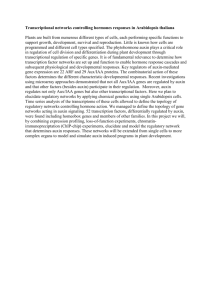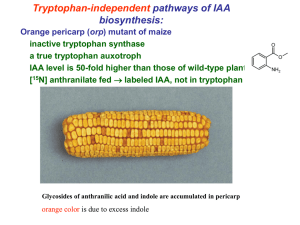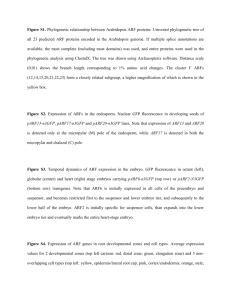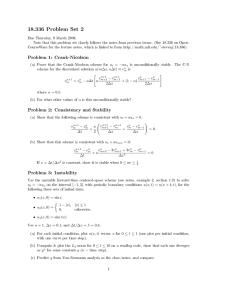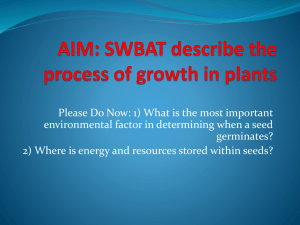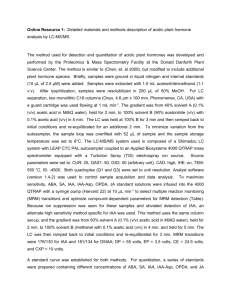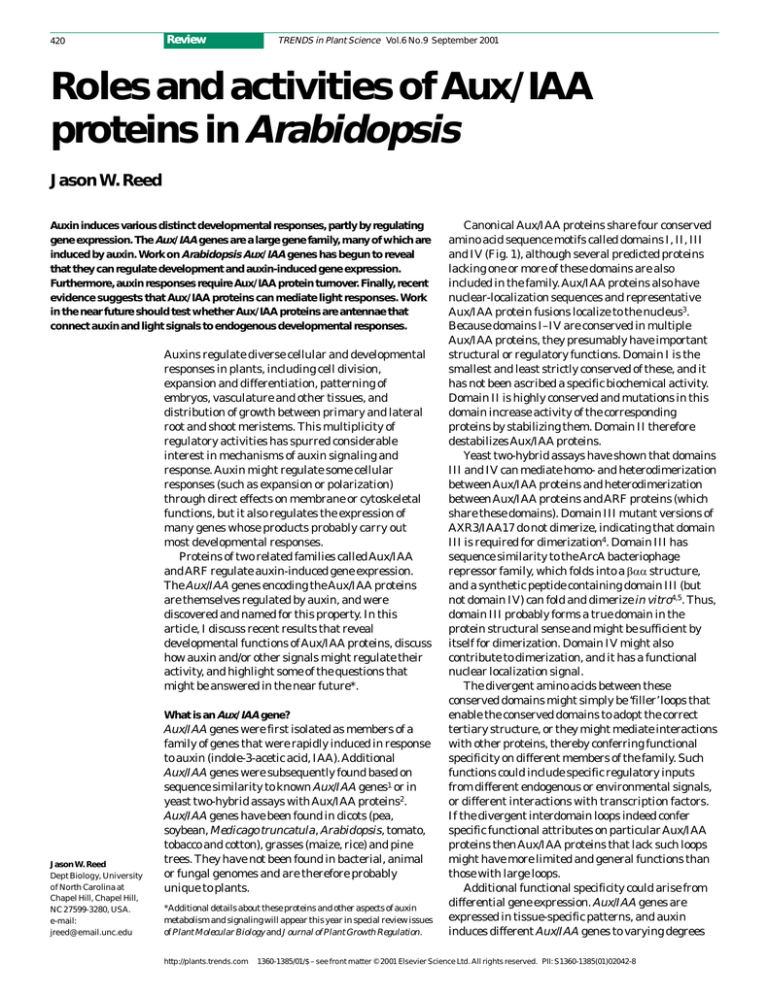
420
Review
TRENDS in Plant Science Vol.6 No.9 September 2001
Roles and activities of Aux/IAA
proteins in Arabidopsis
Jason W. Reed
Auxin induces various distinct developmental responses, partly by regulating
gene expression. The Aux/IAA genes are a large gene family, many of which are
induced by auxin. Work on Arabidopsis Aux/IAA genes has begun to reveal
that they can regulate development and auxin-induced gene expression.
Furthermore, auxin responses require Aux/IAA protein turnover. Finally, recent
evidence suggests that Aux/IAA proteins can mediate light responses. Work
in the near future should test whether Aux/IAA proteins are antennae that
connect auxin and light signals to endogenous developmental responses.
Auxins regulate diverse cellular and developmental
responses in plants, including cell division,
expansion and differentiation, patterning of
embryos, vasculature and other tissues, and
distribution of growth between primary and lateral
root and shoot meristems. This multiplicity of
regulatory activities has spurred considerable
interest in mechanisms of auxin signaling and
response. Auxin might regulate some cellular
responses (such as expansion or polarization)
through direct effects on membrane or cytoskeletal
functions, but it also regulates the expression of
many genes whose products probably carry out
most developmental responses.
Proteins of two related families called Aux/IAA
and ARF regulate auxin-induced gene expression.
The Aux/IAA genes encoding the Aux/IAA proteins
are themselves regulated by auxin, and were
discovered and named for this property. In this
article, I discuss recent results that reveal
developmental functions of Aux/IAA proteins, discuss
how auxin and/or other signals might regulate their
activity, and highlight some of the questions that
might be answered in the near future*.
What is an Aux/IAA gene?
Jason W. Reed
Dept Biology, University
of North Carolina at
Chapel Hill, Chapel Hill,
NC 27599-3280, USA.
e-mail:
jreed@email.unc.edu
Aux/IAA genes were first isolated as members of a
family of genes that were rapidly induced in response
to auxin (indole-3-acetic acid, IAA). Additional
Aux/IAA genes were subsequently found based on
sequence similarity to known Aux/IAA genes1 or in
yeast two-hybrid assays with Aux/IAA proteins2.
Aux/IAA genes have been found in dicots (pea,
soybean, Medicago truncatula, Arabidopsis, tomato,
tobacco and cotton), grasses (maize, rice) and pine
trees. They have not been found in bacterial, animal
or fungal genomes and are therefore probably
unique to plants.
*Additional details about these proteins and other aspects of auxin
metabolism and signaling will appear this year in special review issues
of Plant Molecular Biology and Journal of Plant Growth Regulation.
http://plants.trends.com
Canonical Aux/IAA proteins share four conserved
amino acid sequence motifs called domains I, II, III
and IV (Fig. 1), although several predicted proteins
lacking one or more of these domains are also
included in the family. Aux/IAA proteins also have
nuclear-localization sequences and representative
Aux/IAA protein fusions localize to the nucleus3.
Because domains I–IV are conserved in multiple
Aux/IAA proteins, they presumably have important
structural or regulatory functions. Domain I is the
smallest and least strictly conserved of these, and it
has not been ascribed a specific biochemical activity.
Domain II is highly conserved and mutations in this
domain increase activity of the corresponding
proteins by stabilizing them. Domain II therefore
destabilizes Aux/IAA proteins.
Yeast two-hybrid assays have shown that domains
III and IV can mediate homo- and heterodimerization
between Aux/IAA proteins and heterodimerization
between Aux/IAA proteins and ARF proteins (which
share these domains). Domain III mutant versions of
AXR3/IAA17 do not dimerize, indicating that domain
III is required for dimerization4. Domain III has
sequence similarity to the ArcA bacteriophage
repressor family, which folds into a βαα structure,
and a synthetic peptide containing domain III (but
not domain IV) can fold and dimerize in vitro4,5. Thus,
domain III probably forms a true domain in the
protein structural sense and might be sufficient by
itself for dimerization. Domain IV might also
contribute to dimerization, and it has a functional
nuclear localization signal.
The divergent amino acids between these
conserved domains might simply be ‘filler’ loops that
enable the conserved domains to adopt the correct
tertiary structure, or they might mediate interactions
with other proteins, thereby conferring functional
specificity on different members of the family. Such
functions could include specific regulatory inputs
from different endogenous or environmental signals,
or different interactions with transcription factors.
If the divergent interdomain loops indeed confer
specific functional attributes on particular Aux/IAA
proteins then Aux/IAA proteins that lack such loops
might have more limited and general functions than
those with large loops.
Additional functional specificity could arise from
differential gene expression. Aux/IAA genes are
expressed in tissue-specific patterns, and auxin
induces different Aux/IAA genes to varying degrees
1360-1385/01/$ – see front matter © 2001 Elsevier Science Ltd. All rights reserved. PII: S1360-1385(01)02042-8
Review
TRENDS in Plant Science Vol.6 No.9 September 2001
I
II
III
IV
IAA
Instability
Dimerization
ARF
DNA binding
(Transcription activation)
Dimerization
TRENDS in Plant Science
Fig. 1. Structure of
Aux/IAA and ARF
proteins. Conserved
domains present in most
Aux/IAA or ARF proteins
are indicated. Domain I of
Aux/IAA proteins is about
nine amino acids long,
domain II is ~15 amino
acids long, domain III is
~40 amino acids long and
domain IV is ~45 amino
acids long. Sequences
between the conserved
domains vary in size, so
that the conserved
domains form between a
third and two-thirds of
each protein. ARF
domains III and IV are
similar to the
corresponding domains
of Aux/IAA proteins. The
middle region of some,
but not all, ARF proteins
can activate transcription13.
Some Aux/IAA and ARF
proteins lack one or more
of the conserved
domains. For example,
IAA20 lacks domain II and
ARF3/ETTIN lacks
domains III and IV.
and with different kinetics1. Auxin does not induce,
and can even repress, other Aux/IAA genes6. These
differences in auxin induction kinetics suggest
that some Aux/IAA genes are part of early
responses, whereas others might be secondary
auxin response genes.
The completion of the Arabidopsis genome
sequence has provided the most complete information
on the Aux/IAA gene family for this species.
Arabidopsis has 25 deduced genes encoding Aux/IAA
proteins that have all four of the conserved domains
that define the family. In addition, at least four
predicted sequences bear similarity to portions of
Aux/IAA proteins but lack one or two of the conserved
domains. Some of the deduced sequences might be
pseudogenes, because no information about
expression is available for several of them.
Arabidopsis Aux/IAA genes have been given IAAx
designations (such as IAA1 and IAA2) and several of
them have compound names (e.g. AXR3/IAA17) that
reflect the phenotypes of mutants in the
corresponding genes. Arabidopsis Aux/IAA and ARF
gene Accession numbers, genomic locations and
protein sequence phylogenies have been compiled in
two recent reviews7,8.
Aux/IAA proteins interact with ARF proteins
A related class of 23 Arabidopsis genes called ARFs
encode auxin response factors9,10. Typical ARF
proteins have C-terminal domains homologous to
domains III and IV of Aux/IAA proteins (Fig. 1).
Domains III and IV enable ARF proteins to interact
with Aux/IAA proteins in yeast two-hybrid assays2,11.
ARF proteins also have a highly conserved
N-terminal DNA-binding domain that binds to
auxin-response elements in promoters of auxinregulated genes, and a divergent middle region that
can activate transcription in some ARFs but has
unknown function in others12,13. Taken together,
these results suggest that Aux/IAA proteins regulate
gene expression by interacting with ARF proteins to
alter their activity (Fig. 2).
In light of this model, functions of ARF proteins
are likely to provide insight into functions of
Aux/IAA proteins that might interact with them.
Mutations in genes encoding three ARF proteins
indicate that they mediate auxin responses. The
ettin/arf3 mutations affect floral patterning14,
monopteros/arf5 mutations affect formation of
vasculature and embryonic phyllotaxy15,16, and
http://plants.trends.com
421
msg1/nph4/arf7 mutations decrease auxin
sensitivity in the hypocotyl and leaf, and cause
defective tropic responses and auxin-regulated gene
expression17–20. All three of these developmental
phenotypes reflect processes that depend on spatial
gradients of auxin concentration21–25, suggesting
that these three ARF proteins might control cell
fate decisions in response to local auxin
concentrations. ETTIN/ARF3 probably does not
interact physically with Aux/IAA proteins because it
lacks domains III and IV. However, competition
among ARFs for auxin-binding promoter elements
might provide an indirect means for interactions
with Aux/IAA proteins.
Developmental functions of Aux/IAA genes
Mutations in Aux/IAA genes have been detected in
several distinct screens for plants with altered
auxin response or morphology (Table 1), and
characterizations of these mutants have begun to
reveal developmental roles of the corresponding
genes. Each of these mutations changes an amino
acid in domain II (Table 1), and genetic and
molecular studies indicate that they cause gain of
function. For each mutation, some or all of the
mutant phenotypes are dominant or semidominant,
and the domain II mutant alleles axr2-1, axr3-1,
shy2-2, iaa28-1, slr-1 and bdl-1 can each
recapitulate mutant phenotypes when introduced
into wild-type plants6,26,27 (P. Nagpal and J.W. Reed,
unpublished; H. Fukaki and M. Tasaka, pers.
commun.; T. Hamann and G. Jürgens, pers.
commun.). The wild-type AXR3/IAA17 gene also
confers axr3-1-like phenotypes when
overexpressed27, although this is not true for wildtype IAA28 or SHY2/IAA3 genes6 (Q. Tian and J.W.
Reed, unpublished). Moreover, intragenic mutations
with molecular characteristics of loss-of-function
mutations suppress the phenotypes of the gain-offunction axr2-1, axr3-1 and shy2-2 mutations26,28–30.
Several of these intragenic suppressors affect single
amino acids in domains I, III or IV, confirming the
importance of these domains for activity of the
gain-of-function proteins.
These domain II mutations in different Aux/IAA
genes affect various tissues and developmental
responses, including root or shoot gravitropism,
lateral root formation, shoot apical dominance, stem
elongation, leaf expansion and leaf formation in the
dark (Table 1). In general, the phenotypes can be
explained in terms of reduced auxin response, and
some auxin-induced genes are expressed at lower
levels in axr2-1 and shy2-2 mutants1 (Q. Tian and
J.W. Reed, unpublished). However, axr3-1 plants have
some phenotypes consistent with hypersensitivity to
auxin, such as ectopic expression of an auxinregulated gene and formation of adventitious roots31.
Therefore, Aux/IAA proteins might both activate and
inhibit auxin responses, depending on the particular
Aux/IAA protein and/or the tissue.
Review
422
TRENDS in Plant Science Vol.6 No.9 September 2001
AXR1, ECR1 Rub
Light
AXR1, ECR1
Phytochromes
SCFTIR1
Aux/IAA P
?
PINOID
E2
Ub
SCFTIR1 Rub
?
?
?
Auxin
?
Aux/IAA Ub
Aux/IAA
MAPK
Aux/IAA Ub
Degraded by
proteasome
Aux/IAA
ARF
ARF
Other gene induction
Developmental responses
Aux/IAA gene induction
TRENDS in Plant Science
Fig. 2. Working model indicating possible input and output regulatory interactions of Aux/IAA
proteins. The model is based on correlative results and is therefore probably incorrect in some
particulars. Question marks indicate putative regulatory connections that would be worth testing
biochemically. Putative auxin- or light-regulated phosphorylation events, ubiquitin-mediated
turnover of Aux/IAA proteins and regulatory outputs acting through ARF proteins are indicated.
Rub- and ubiquitin-modification pathways are indicated in abbreviated form33. A putative Aux/IAA
negative feedback loop is indicated as acting through Aux/IAA inhibition of an activating ARF.
Abbreviations: E2, ubiquitin-conjugating enzyme; IAA, indole-3-acetic acid (auxin); MAPK, MAP
kinase cascade; P, phosphate group; Ub, ubiquitin.
Taken together, the gain-of-function mutant
phenotypes suggest that Aux/IAA proteins can
regulate many of the developmental processes
governed by auxin. However, as guides to the normal
functions of these genes, the phenotypes should be
regarded with some caution because they might arise
from levels of Aux/IAA protein activity that are
higher than any reached in the normal course of
development. Ideally, one should compare these
results with phenotypes of loss-of-function mutations
in the same genes. Unfortunately, the putative
Aux/IAA gene null mutants that have been
characterized have subtle phenotypes26,28,29,
probably because of redundant activities or
feedback regulatory loops that enable the mutant
plants to compensate for absence of a particular
Aux/IAA protein. Given the number of Aux/IAA
proteins, the possible promiscuity of their
dimerization interactions and the likelihood of
feedback regulation, it will take considerable effort
to sort out the precise functions of each one.
Does auxin regulate Aux/IAA protein activity?
Notwithstanding these interpretational
uncertainties, the genetic results do suggest that
Aux/IAA proteins regulate gene expression responses
to auxin, and studies of Aux/IAA protein biochemistry
have begun to suggest that they might be targets of
http://plants.trends.com
auxin and possibly other signals. Aux/IAA proteins
have half-lives as short as 6–8 min, and the domain II
mutations probably increase protein function by
stabilizing the corresponding protein3,4,27. The axr3-1
and shy2-2 mutant plants have higher steady-state
levels of the corresponding proteins than do wild-type
plants, and the axr3-1 mutation increased the halflife of AXR3/IAA17 (Refs 4,32). Similarly, fusion
proteins with Ps-IAA6 or AXR3/IAA17 are degraded
rapidly in plant cells, and mutations in domain II
decrease this degradation27 (S. Kepinski and
O. Leyser, pers. commun.).
These findings might explain why several
mutations that affect protein turnover reduce auxin
responses33. For example, mutations in components
of the SCFTIR1 ubiquitin ligase complex cause auxinresistant root growth34. An attractive model to
explain these phenotypes is that SCFTIR1
ubiquitinates Aux/IAA proteins and thereby targets
them to the proteasome (Fig. 2). SCFTIR1 might
normally ubiquitinate Aux/IAA proteins that have an
intact domain II. Either inactivation of the complex
or mutation of domain II would then lead to higher
steady-state levels of one or more Aux/IAA proteins,
in turn decreasing auxin response. The cullin
component of the SCFTIR1 ubiquitin ligase is itself
regulated by AXR1- and ECR1-dependent
modification with the ubiquitin-like molecule Rub,
and mutations in axr1 also confer auxin-resistant
root growth and gene induction, and have reduced
apical dominance1,35,36.
The phenotypes of axr1 and tir1 mutants are less
severe than those of gain-of-function Aux/IAA gene
mutants, which raises the issue of whether the
hypothesized stabilization of Aux/IAA proteins can
fully account for the axr1 and tir1 phenotypes.
Perhaps SCFTIR1 targets only a subset of Aux/IAA
proteins and other ubiquitin ligases (possibly
homologous to SCFTIR1) ubiquitinate other Aux/IAA
proteins. Both AXR1 and TIR1 are members of
multigene families, suggesting that the single
mutants might retain an ability to ubiquitinate
Aux/IAA proteins. Another potential complication is
that Aux/IAA proteins might antagonize each other,
such that stabilizing multiple Aux/IAA proteins
might cause more subtle phenotypes than stabilizing
just one. For example, Aux/IAA proteins might inhibit
each other by dimerizing, and they can also repress
expression of each other’s genes. Finally, in addition
to stabilizing the proteins, domain II mutations might
confer an added biochemical activity that is not
mimicked by mutating the ubiquitination apparatus.
In light of this working model, a question of
immediate interest is whether auxin regulates
Aux/IAA protein turnover. Such regulation could
explain how auxin activates gene expression. There is
no evidence that auxin regulates Rub-conjugating or
SCFTIR1-ubiquitin-ligase activities. Perhaps the most
likely alternative is that auxin causes modification of
Aux/IAA proteins and that such modification enables
Review
TRENDS in Plant Science Vol.6 No.9 September 2001
423
Table 1. Mutations in domain II of different Aux/IAA genesa
Aux/IAA gene and mutationsb
Phenotypes
Refs
Short hypocotyl, leaves in dark, wavy leaves, no root hairs,
agravitropic root and shoot
28,30,54,55
Short hypocotyl, leaves in dark, upcurled leaves,
no root hairs, agravitropic root
29,31
Short hypocotyl, leaves in dark, upcurled leaves
26,40,42,44,c
AXR2/IAA7
axr2-1
VVGWPPVRN
S
AXR3/IAA17
axr3-1
axr3-3
VVGWPPVRS
L
G
SHY2/IAA3
shy2-1, -2
shy2-3
shy2-6
IVGWPPVRS
S
E
L
SLR1/IAA14
slr1-1
VVGWPPVRN
S
No lateral roots, few root hairs, agravitropic root and hypocotyl
c
IAA28
iaa28-1
VVGWPPVRS
L
Few lateral roots, decreased shoot apical dominance
6
MSG2/IAA19
msg2-1
msg2-2
msg2-3
msg2-4
VVGWPPVCS
S
R
L
L
Agravitropic and aphototropic hypocotyl, few lateral roots
d
IAA12
bodenlos
VVGWPPIGL
S
No embryonic root, upcurled leaves
56,e
IAA18
iaa18-1
VVGWPPVRS
E
Long hypocotyl, fused cotyledons, short root, upcurled leaves
f
SHY1/IAA6
shy1-1
AVGWPPVCS
R
Short hypocotyl, upcurled leaves
42,f
aOnly
the most dramatic phenotypes are listed. See Refs for further details.
acid sequences of the conserved stretch of domain II, and changes caused by the listed mutations. For shy1-1 and iaa18-1, the inference
that the indicated mutation causes the phenotypes is based on genetic linkage only. The mutation in shy1-1 in particular causes a conservative
amino acid change, and therefore requires additional evidence.
cH. Fukaki and M. Tasaka, pers. commun.
dK.T. Yamamoto, pers. commun.
eT. Hamann and G. Jürgens, pers. commun.
fP. Nagpal and J.W. Reed, unpublished.
bAmino
them to be recognized by SCFTIR1. In yeasts and
animals, phosphorylation regulates ubiquitination
and the subsequent turnover of many proteins33.
SHY2/IAA3 can be phosphorylated in vivo32, although
no data are available on which factor(s) regulate this
phosphorylation. Both the PINOID kinase and MAP
kinases have been implicated in auxin responses, and
they are therefore candidates for phosphorylating
and thereby possibly regulating the turnover of
Aux/IAA proteins. Mutations in PINOID cause
cotyledon fusions similar to those of mp/arf5 and
iaa18-1 mutants, pin-like inflorescences resembling
those of pin1 auxin-transport-defective mutants and
altered flower structure. In addition, overexpression
of PINOID causes auxin insensitivity37,38. Auxin
increases MAP kinase activity in Arabidopsis roots,
and inhibitors of MAP kinase decrease auxin
induction of a reporter gene construct39.
Do Aux/IAA proteins mediate light responses?
Several results suggest that light can also regulate
Aux/IAA protein activity. For example, the red-light
photoreceptor phytochrome A (phyA) can interact
with two Aux/IAA proteins in the yeast two-hybrid
assay40 and oat phyA can phosphorylate IAA1,
http://plants.trends.com
SHY2/IAA3, IAA9, AXR3/IAA17 and Ps-IAA4 (from
pea) in vitro32. PhyA also phosphorylated a fragment
of SHY2/IAA3 consisting of domains I and II (Ref. 32),
suggesting that phyA recognizes one of these
domains. This in vitro activity was not light
regulated. However, phytochromes move from the
cytoplasm to the nucleus in response to light and
phytochrome translocation could regulate
phytochrome phosphorylation of (nucleus-localized)
Aux/IAA proteins41.
Other data suggest that light might activate
Aux/IAA proteins by stabilizing them. The domain II
mutations axr2-1, axr3-1, shy2-1 and shy2-2 each
cause seedlings to develop leaves when grown in
darkness28,42–44. Also consistent with this idea, an
antisense construct that decreases function of the
Arabidopsis COP9 complex, which is required to
prevent de-etiolation in darkness, decreased the
turnover rate of a Ps-IAA6::luciferase protein fusion
in transgenic plants45. Intriguingly, the COP9
complex removes Rub modification of cullins, the
reverse enzymatic activity to that catalyzed by AXR1
and ECR1 (Refs 45,46).
In addition to Aux/IAA gene mutations that affect
de-etiolation, msg2 mutations in IAA19 decrease
424
Review
TRENDS in Plant Science Vol.6 No.9 September 2001
phototropism (K.T. Yamamoto, pers. commun.). These
results raise the possibility that the photoreceptor
NPH1 might regulate phototropism through
interactions with Aux/IAA proteins. NPH1 is a lightregulated kinase47, although there is currently no
evidence that it can phosphorylate Aux/IAA proteins.
Intriguingly, the kinase domain of NPH1 is related to
the PINOID kinase, suggesting that this family might
have a general role in auxin responses. However,
NPH1 associates with the plasma membrane and
therefore might not be able to interact directly with
MSG2/IAA19 unless one of the proteins can shuttle
between the cytoplasm and the nucleus.
If Aux/IAA proteins do mediate light responses
then loss-of-function mutations in Aux/IAA genes
should decrease light responses. Presumed null
mutations in SHY2/IAA3 and AXR2/IAA7 cause
transient increases in hypocotyl elongation rates26,28.
However, these phenotypes are much subtler than
those caused by mutations in photoreceptor genes.
Because phyA can phosphorylate any of several
different Aux/IAA proteins in vitro, construction and
characterization of double or higher-order mutants
lacking multiple potentially redundant Aux/IAA
proteins might provide more convincing evidence of
their importance in light responses.
Why does auxin regulate Aux/IAA gene expression?
The protein ubiquitination machinery and the
multiple kinases and photoreceptors already
described might regulate Aux/IAA protein stability or
some other aspect of Aux/IAA protein activity. There
is no evidence that Aux/IAA proteins bind specific
DNA sequences and therefore the simplest model to
explain how Aux/IAA proteins exert their effects is
that they dimerize with ARF proteins and thereby
modulate auxin-regulated gene expression. In a
transient expression assay in carrot protoplasts, any
of several Aux/IAA proteins could inhibit auxininduced gene expression11, suggesting that Aux/IAA
proteins can inhibit the activity of ARFs that contain
an activating middle region. Also consistent with this
idea, axr2-1 and shy2-2 mutations decrease
expression of several auxin-regulated genes1 (Q. Tian
and J.W. Reed, unpublished). More complicated
scenarios are also possible. For example, Aux/IAA
proteins might dimerize with ARFs that do not
contain an activation domain, and this interaction
might either inhibit a repressing activity or confer
some novel activity on these ARFs.
Aux/IAA genes were discovered based on their
induction by auxin and some (such as AXR3/IAA17)
can promote auxin responses. However, many
Aux/IAA proteins actually inhibit auxin responses.
These Aux/IAA-mediated negative feedbacks could
have at least two purposes for plant development.
They might impose a requirement for persistent (or
perhaps accelerated) auxin signal input to cause a
lasting developmental change. In fact, auxin induces
some genes (including several Aux/IAA genes)
http://plants.trends.com
transiently1. Negative feedback loops might also
enable more precise control of output level than would
an undamped inductive system, which might
overshoot. This would permit a close correlation
between auxin level and target gene expression in
different cells, and such a graded response would
allow auxin to function as a morphogen in tissue
patterning. Auxin gradients have indeed been
implicated in patterning various tissues, including
apical–basal organization in the gynoecium24,
phyllotaxy in the shoot apical meristem23, cellular
organization of the root meristem48, radial patterning
of the vascular cambium49,50 and development of leaf
vasculature21,22. Such patterning might also require
intercellular feedbacks so that cells in a gradient of
auxin concentration could detect their relative
position. Altered root meristem patterns in axr2-1
and axr3-1 mutants48 and altered cotyledon
phyllotaxy in iaa18-1 mutant plants also suggest that
Aux/IAA proteins might regulate patterning. As
already discussed, several different ARFs have also
been implicated in tissue patterning.
In addition to Aux/IAA genes themselves, the
targets of Aux/IAA and ARF regulation might include
genes whose products carry out developmental
responses to auxin. Most of these remain to be
discovered but they might include genes encoding the
ethylene biosynthetic enzyme ACC synthase,
transcription factors of the HD-Zip class and other
early auxin response genes of the SAUR and GH3
families51. We know little about the functions of most
of these genes or the proteins they encode, and studies
of these auxin-regulated genes should provide insight
into how they might mediate developmental
processes induced by auxin. Mutations in one GH3
gene decrease responses to phytochrome A (Ref. 52)
and overexpression of another GH3 gene confers a
short hypocotyl and auxin-resistant root growth53.
These results suggest that GH3 proteins also mediate
light responses. It is an open question whether GH3
proteins are part of the same regulatory machinery as
ARF and Aux/IAA proteins or whether they act
through independent pathways.
What do we still need to know?
Recent progress toward discovering the functions of
Aux/IAA genes has come from the fortuitous discovery
of gain-of-function mutations in several of these
genes. However, we do not know the precise
developmental functions of each of these genes and
analyses of loss-of-function single and multiple
mutants might lead to the next advances in
understanding Aux/IAA gene function. We would also
like to know the extent to which Aux/IAA proteins
function as antennae for the myriad hormonal and
environmental signals that influence the basic
mechanisms of cell growth, division and
differentiation, and the extent to which Aux/IAA
proteins can integrate multiple signals. In vivo
biochemical studies will be essential to understand
Review
Acknowledgements
I thank Joe Kieber and
Punita Nagpal for
comments on the
manuscript.
TRENDS in Plant Science Vol.6 No.9 September 2001
whether (and how) auxin and other signals regulate
the activity of the Aux/IAA and/or ARF proteins, and
might provide important insight into how auxin is
perceived. Finally, global gene expression studies of
References
1 Abel, S. et al. (1995) The PS-IAA4/5-like family
of early auxin-inducible mRNAs in Arabidopsis
thaliana. J. Mol. Biol. 251, 533–549
2 Kim, J. et al. (1997) Protein–protein interactions
among the Aux/IAA proteins. Proc. Natl. Acad.
Sci. U. S. A. 94, 11786–11791
3 Abel, S. et al. (1994) Early auxin-induced genes
encode short-lived nuclear proteins. Proc. Natl.
Acad. Sci. U. S. A. 91, 326–330
4 Ouellet, F. et al. (2001) IAA17/AXR3: biochemical
insight into an auxin mutant phenotype. Plant
Cell 13, 829–841
5 Morgan, K.E. et al. (1999) Biochemical
characterization of recombinant polypeptides
corresponding to the predicted beta-alpha-alpha
fold in Aux/IAA proteins. FEBS Lett.
454, 283–287
6 Rogg, L.E. et al. (2001) A gain-of-function
mutation in IAA28 suppresses lateral root
development. Plant Cell 13, 465–480
7 Hagen, G. and Guilfoyle, T. Auxin-responsive
gene expression: genes, promoters, and
regulatory factors. Plant Mol. Biol. (in press)
8 Liscum, E. and Reed, J.W. Genetics of Aux/IAA
and ARF action in plant growth and development.
Plant Mol. Biol. (in press)
9 Guilfoyle, T. et al. (1998) How does auxin turn on
genes? Plant Physiol. 118, 341–347
10 Guilfoyle, T.J. et al. (1998) The ARF family of
transcription factors and their role in plant
hormone-responsive transcription. Cell Mol.
Life Sci. 54, 619–627
11 Ulmasov, T. et al. (1997) Aux/IAA proteins repress
expression of reporter genes containing natural
and highly active synthetic auxin response
elements. Plant Cell 9, 1963–1971
12 Ulmasov, T. et al. (1999) Dimerization and DNA
binding of auxin response factors. Plant J.
19, 309–319
13 Ulmasov, T. et al. (1999) Activation and repression
of transcription by auxin-response factors. Proc.
Natl. Acad. Sci. U. S. A. 96, 5844–5849
14 Sessions, A. et al. (1997) ETTIN patterns the
Arabidopsis floral meristem and reproductive
organs. Development 124, 4481–4491
15 Przemeck, G.K.H. et al. (1996) Studies on the
role of the Arabidopsis gene MONOPTEROS in
vascular development and plant cell axialization.
Planta 200, 229–237
16 Hardtke, C.S. and Berleth, T. (1998) The
Arabidopsis gene MONOPTEROS encodes a
transcription factor mediating embryo axis
formation and vascular development. EMBO J.
17, 1405–1411
17 Watahiki, M.K. and Yamamoto, K. (1997) The
massagu1 mutation of Arabidopsis identified with
failure of auxin-induced growth curvature of
hypocotyl confers auxin insensitivity to hypocotyl
and leaf. Plant Physiol. 115, 419–426
18 Liscum, E. and Briggs, W.R. (1996) Mutations of
Arabidopsis in potential transduction and
response components of the phototropic signaling
pathway. Plant Physiol. 112, 291–296
19 Stowe-Evans, E.L. et al. (1998) NPH4, a
conditional modulator of auxin-dependent
http://plants.trends.com
20
21
22
23
24
25
26
27
28
29
30
31
32
33
34
35
36
37
38
425
both gain- and loss-of-function mutants might reveal
the regulatory targets of Aux/IAA and ARF proteins,
thereby providing a clearer view of how auxinregulated developmental processes unfold.
differential growth responses in Arabidopsis.
Plant Physiol. 118, 1265–1275
Harper, R.M. et al. (2000) The NPH4 locus
encodes the auxin response factor ARF7, a
conditional regulator of differential growth in
aerial Arabidopsis tissue. Plant Cell 12, 757–770
Sieburth, L. (1999) Auxin is required for leaf vein
pattern in Arabidopsis. Plant Physiol.
121, 1179–1190
Mattsson, J. et al. (1999) Responses of plant
vascular systems to auxin transport inhibition.
Development 126, 2979–2991
Reinhardt, D. et al. (2000) Auxin regulates the
initiation and radial position of plant lateral
organs. Plant Cell 12, 507–518
Nemhauser, J.L. et al. (2000) Auxin and ETTIN
in Arabidopsis gynoecium morphogenesis.
Development 127, 3877–3888
Kaufman, P.B. et al. (1995) Hormones and
orientation of growth. In Plant Hormones
(Davies, P.J., ed.), pp. 547–571, Kluwer Academic
Publishers
Tian, Q. and Reed, J.W. (1999) Control of
auxin-regulated root development by the
Arabidopsis thaliana SHY2/IAA3 gene.
Development 126, 711–721
Worley, C.K. et al. (2000) Degradation of Aux/IAA
proteins is essential for normal auxin signaling.
Plant J. 21, 553–562
Nagpal, P. et al. (2000) AXR2 encodes a member
of the Aux/IAA protein family. Plant Physiol.
123, 563–573
Rouse, D. et al. (1998) Changes in auxin
response from mutations in an AUX/IAA gene.
Science 279, 1371–1373
Timpte, C. et al. (1994) The axr2-1 mutation of
Arabidopsis thaliana is a gain-of-function
mutation that disrupts an early step in auxin
response. Genetics 138, 1239–1249
Leyser, H.M.O. et al. (1996) Mutations in the
AXR3 gene of Arabidopsis result in altered auxin
response including ectopic expression from the
SAUR-AC1 promoter. Plant J. 10, 403–413
Colón-Carmona, A. et al. (2000) Aux/IAA proteins
are phosphorylated by phytochrome in vitro.
Plant Physiol. 124, 1728–1738
Gray, W.M. and Estelle, M. (2000) Function of the
ubiquitin–proteasome pathway in auxin
response. Trends Biochem. Sci. 25, 133–138
Gray, W.M. et al. (1999) Identification of an SCF
ubiquitin-ligase complex required for auxin
response in Arabidopsis thaliana. Genes Dev.
13, 1678–1691
Timpte, C. et al. (1995) The AXR1 and AUX1
genes of Arabidopsis function in separate
auxin-response pathways. Plant J. 8, 561–569
del Pozo, J.C. and Estelle, M. (1999) The
Arabidopsis cullin AtCUL1 is modified by the
ubiquitin-related protein RUB1. Proc. Natl.
Acad. Sci. U. S. A. 96, 15342–15347
Christensen, S.K. et al. (2000) Regulation of auxin
response by the protein kinase PINOID. Cell
100, 469–478
Bennett, S.R.M. et al. (1995) Morphogenesis in
pinoid mutants of Arabidopsis thaliana. Plant J.
8, 505–520
39 Mockaitis, K. and Howell, S.H. (2000) Auxin
induces mitogenic activated protein kinase
(MAPK) activation in roots of Arabidopsis
seedlings. Plant J. 24, 785–796
40 Soh, M.S. et al. (1999) Regulation of both lightand auxin-mediated development by the
Arabidopsis IAA3/SHY2 gene. J. Plant Biol.
42, 239–246
41 Reed, J.W. (1999) Phytochromes are Pr-ipatetic
kinases. Curr. Opin. Plant Biol. 2, 393–397
42 Kim, B.C. et al. (1996) Two dominant
photomorphogenic mutations of Arabidopsis
thaliana identified as suppressor mutations of
hy2. Plant J. 9, 441–456
43 Kim, B.C. et al. (1998) Photomorphogenic
development of the Arabidopsis shy2-1D
mutation and its interaction with phytochromes
in darkness. Plant J. 15, 61–68
44 Reed, J.W. et al. (1998) Suppressors of an
Arabidopsis thaliana phyB mutation identify
genes that control light signalling and hypocotyl
elongation. Genetics 148, 1295–1310
45 Schwechheimer, C. et al. (2001) Interactions of the
COP9 signalosome with the E3 ubiquitin ligase
SCFTIR1 in mediating auxin response. Science
292, 1379–1382
46 Lyapina, S. et al. (2001) Promotion of
NEDD8–CUL1 conjugate cleavage by COP9
signalosome. Science 292, 1382–1385
47 Christie, J.M. et al.(1998) Arabidopsis NPH1: a
flavoprotein with the properties of a photoreceptor
for phototropism. Science 282, 1698–1701
48 Sabatini, S. et al. (1999) An auxin-dependent
distal organizer of pattern and polarity in the
Arabidopsis root. Cell 99, 463–472
49 Tuominen, H. et al. (1997) A radial concentration
gradient of indole-3-acetic acid is related to
secondary xylem development in hybrid aspen.
Plant Physiol. 115, 577–585
50 Uggla, C. et al. (1998) Indole-3-acetic acid
controls cambial growth in Scots pine by
positional signaling. Plant Physiol. 117, 113–121
51 Guilfoyle, T.J. (1999) Auxin-regulated genes and
promoters. In Biochemistry and Molecular
Biology of Plant Hormones (Hooykaas, P.J.J. et al.,
eds), pp. 423–459, Elsevier
52 Hsieh, H-L. et al. (2000) FIN219, an auxinregulated gene, defines a link between
phytochrome A and the downstream regulator
COP1 in light control of Arabidopsis development.
Genes Dev. 14, 1958–1970
53 Nakazawa, M. et al. (2001) DFL1, an auxinresponsive GH3 gene homologue, negatively
regulates shoot cell elongation and lateral root
formation, and positively regulates the light
response of hypocotyl length. Plant J. 25, 213–221
54 Timpte, C.S. et al. (1992) Effects of the axr2
mutation of Arabidopsis on cell shape in hypocotyl
and inflorescence. Planta 188, 271–278
55 Wilson, A.K. et al. (1990) A dominant mutation in
Arabidopsis confers resistance to auxin, ethylene
and abscisic acid. Mol. Gen. Genet. 222, 377–383
56 Hamann, T. et al. (1999) The auxin-insensitive
bodenlos mutation affects primary root formation
and apical–basal patterning in the Arabidopsis
embryo. Development 126, 1387–1395

